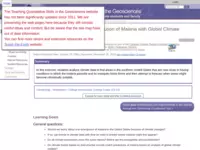https://serc.carleton.edu/quantskills/activities/savina.html
Mary Savina, Kendra Murray, Carleton College, SERC Teaching Quantitative Skills in the Geosciences Collection
Activity takes about two weeks of class time including homework assignments. Computer with Internet access required.
Learn more about Teaching Climate Literacy and Energy Awareness»Grade Level
Regional Focus
Climate Literacy
This Activity builds on the following concepts of Climate Literacy.
Click a topic below for supporting information, teaching ideas, and sample activities.
Excellence in Environmental Education Guidelines
Other materials addressing:
G) Drawing conclusions and developing explanations.
Other materials addressing:
C) Collecting information.
Other materials addressing:
E) Organizing information.
Other materials addressing:
A) Human/environment interactions.
Other materials addressing:
E) Environmental Issues.
Notes From Our Reviewers
The CLEAN collection is hand-picked and rigorously reviewed for scientific accuracy and classroom effectiveness.
Read what our review team had to say about this resource below or learn more about
how CLEAN reviews teaching materials
Teaching Tips | Science | Pedagogy |
Technical Details
Teaching Tips
- An extensive list of tips is provided on the activity sheet.
- It may be helpful to pair students that are skilled in working with spreadsheets and GIS with students that may need support in working with these tools.
About the Content
- Data sets end in 2003 but still accomplish the objective learning goals for the activity. Instructor may challenge students to find more recent relevant data and update the spreadsheets provided.
- Thoroughly-written background information with plenty of good citations.
- Comments from expert scientist:
Scientific strengths:
- This resource asks students to work with and interpret real climate data.
- It confronts some of the ambiguities associated with climate change impacts on human health.
Suggestions:
- The resource could be updated for an analysis of vulnerability to tropical diseases that are of current concern for spread into the United States, such as dengue fever or chikungunya.
- This activity is fifteen years old, leaving off a substantial portion of climate change in the southeastern United States. (This is especially relevant since the warmth of the past fifteen years has actually caused a change in sign of the long-term trend in many temperature parameters.) Suggest using more recent climate data.
About the Pedagogy
- Students read and internalize scientific literature in order to put together a class presentation using PowerPoint.
- Students gain experience analyzing real data sets using Excel. There is a guide for using Excel for this project that is very helpful.
- This activity involves two or more students working together on a project and presentation.
- This resource engages students in using scientific data.
See other data-rich activities








